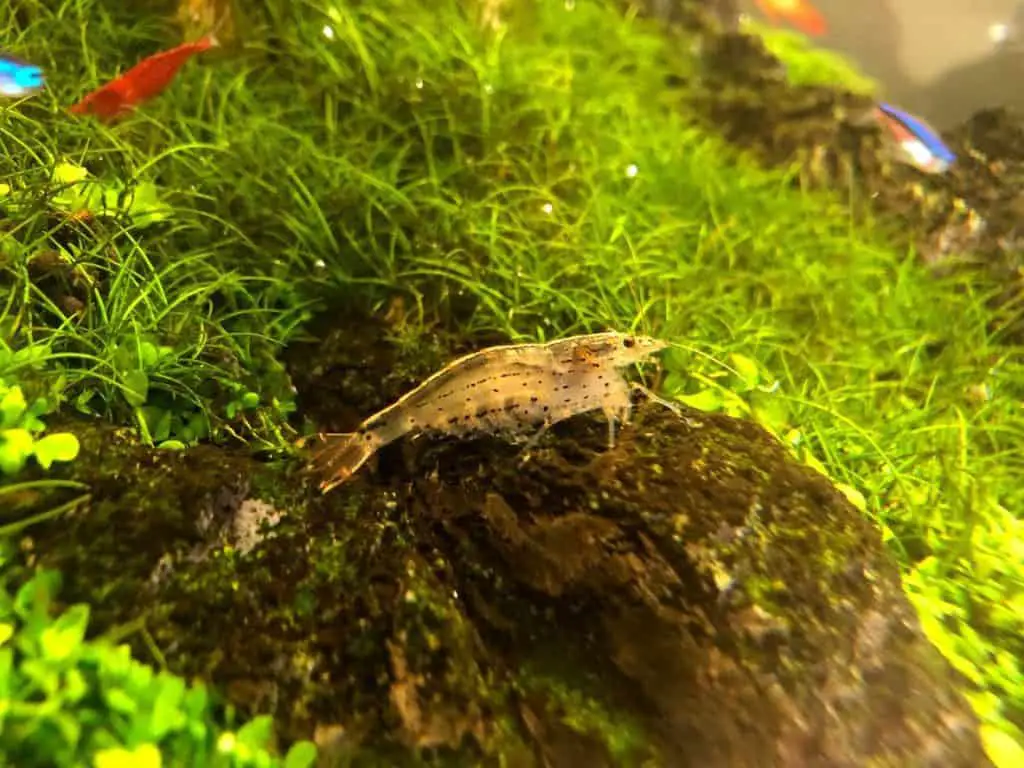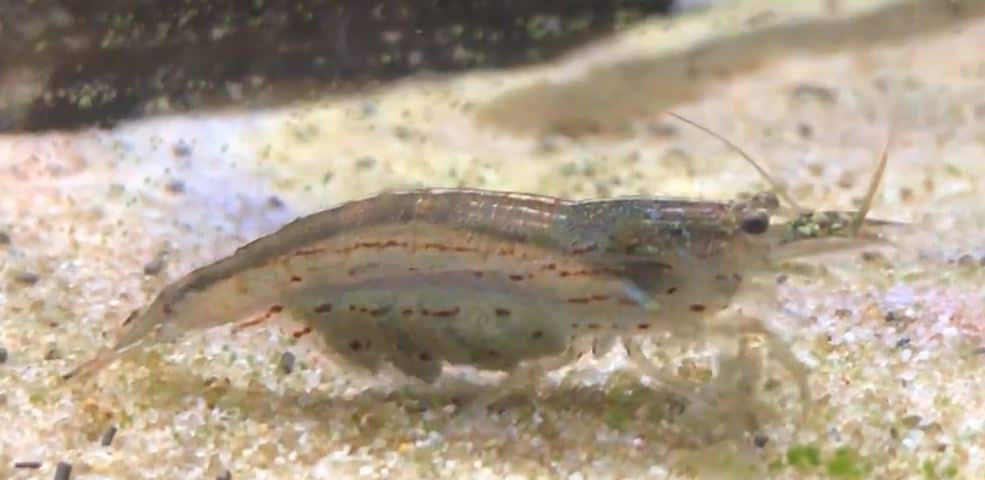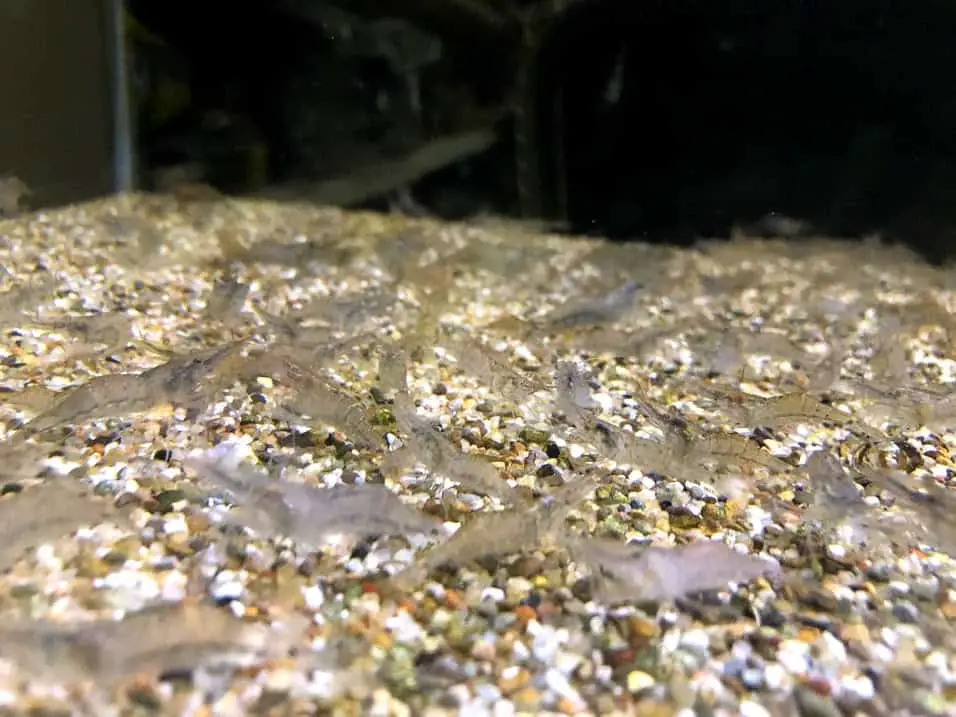Amano shrimp and Ghost shrimp, are there any differences and or similarities between these two shrimp species? Keen to discover the differences and similarities between the Amano shrimp and the Ghost shrimp and how to tell them apart? We dig deeper into their
Amano shrimp are larger than ghost shrimp, growing up to 2 inches long, and have a translucent body with brownish-gray coloration. On the other hand, ghost shrimp grow up to 1.5 inches in length and have a transparent or translucent appearance.
- Amano Shrimp Vs Ghost Shrimp
- Interesting Amano Shrimp Facts
- Interesting Ghost Shrimp Facts
- Significant Differences Between the Amano and Ghost Shrimp
- Similarities Between the Amano and Ghost Shrimp
- How to Keep and Breed Amano Shrimp
- How to Keep and Breed Ghost Shrimp
- Physical Characteristics of Amano Shrimp vs. Ghost Shrimp
- How Amano Shrimp and Ghost Shrimp Behave in An Aquarium
- Potential Challenges or Considerations When Keeping Ghost Shrimp and Amano Shrimp Together
- Frequently Asked Questions
- What is the difference between Amano Shrimp and Ghost Shrimp?
- How can I tell Amano Shrimp and Ghost Shrimp apart?
- Where do Amano Shrimp and Ghost Shrimp live?
- Do Amano Shrimp live longer than Ghost Shrimp?
- Are Amano Shrimp smaller than Ghost Shrimp?
- What do Amano Shrimp and Ghost Shrimp eat?
- Can Amano Shrimp and Ghost Shrimp live together?
- Can Ghost Shrimp live with other fish or shrimp?
- Can Amano Shrimp and Ghost Shrimp eat the same food?
- What's the difference between Amano Shrimp and Ghost Shrimp if they're both shrimp?
- Related Questions
- Final thoughts
Amano Shrimp Vs Ghost Shrimp
Amano shrimp and ghost shrimp are both popular choices for aquarium enthusiasts. Amano shrimp, also known as Caridina multidentata, are larger and known for their appetite for algae, making them great for keeping tanks clean. They are a type of shrimp native to the island nation of Japan and Thailand. Amano shrimp are commonly found in sea-bound rivers.
Ghost shrimp, also Glass shrimp, are known by their scientific classification Palaemonetes paludosu, are smaller and known for their transparent appearance. They are often used as feeder shrimp or for their scavenging abilities. They are freshwater shrimp native to southern USA water bodies.
Interesting Amano Shrimp Facts
Amano shrimp are native to several Asian countries, including Korea, Taiwan, and Japan. In Japan, shrimp are widely found in the Yamato River. They are easy to recognize thanks to their transparent grey bodies, which feature small circular markings on either side.
The fastest way to distinguish between a male Amano and a female Amano shrimp is to look at the bottom row of circular markings. Male Amanos have a single line of these markings, while their female counterparts’ lines are longer.
Amano shrimp can be kept as a pet if you want to start an in-house fish tank or add them to your current fish tank. They make efficient tank cleaners thanks to their algae-eating nature. Thanks to their peaceful nature and unique appearance, they are also a great addition to any fish tank.
Interesting Ghost Shrimp Facts
Ghost shrimp are so named because of their appearance. Yes, they are transparent, making it hard to see in the water. Their other name is glass shrimp.
They are so transparent and clear that you can watch the food they eat pass from their mouth to their stomach!
Ghost shrimp, like all shrimp, shed their outer skeleton every few months in a process known as molting. It is a tough experience for a shrimp, and you will notice that they will tend to hide throughout the process until their new skeleton is strong enough.
Glass or Ghost shrimp will live in the wild from 6 to 14 months. They can live up to 3 years in an aquarium where conditions are more stable and constant.
Significant Differences Between the Amano and Ghost Shrimp
Conditions for Larvae Growth
One of the major differences between Amano shrimp and Ghost shrimp is where they live when they are shrimplets. When the two species lay their eggs and the larvae develop, the type of water needed to grow and survive differs.
Amano larvae need to develop in saltwater, while Ghost larvae need a freshwater source.
Differentiation of Genders
Amano males and females can be distinguished by their gender markings. The dots on either side of Amano shrimp’s bodies help recognize the two genders.
Male Amanos have a series of dots on their bodies, while female Amanos have a similar set of dots that are more extended than their male counterparts.
Ghost males and females don’t have body markings to identify them quickly. You have to do a full body morphological study to distinguish between them.
Female Ghost shrimp tend to be rounded in their bellies, while male Ghost shrimp are slanted in shape. Females Ghost shrimp are also significantly larger than their male counterparts when they reach maturity.
Similarities Between the Amano and Ghost Shrimp
Amano and Glass Shrimp Food
Both Amano shrimp and Ghost shrimp eat more or less the same things. However, Amano is primarily known as algae eaters, while Ghost shrimps are widely sold as bottom feeders. Both are omnivores and clean up your tank, but the Amano shrimp prefers algae more than the Glass Shrimp.
Similar in Size
Perhaps because their diets are similar, the two species are about the same size. The average Amano and Ghost female shrimp adult size is almost 2 inches long, while the males of both species are a fraction smaller.
Similar Behavior
Amano’s and Ghost shrimp share similar behavior. They can be greedy when it is feeding time, but overall, they are pretty peaceful and seem to get along fine with other animals in a tank.
When not foraging for food, you will see these two playing hide-and-seek among the plants in the fish tank.
They are quite shy and won’t venture out unless they feel safe, hence the need for a lot of shrimp tubing and live plants in your tank.
Breeding time is when you’ll see the most activity from these little guys as the male and female chase each other in what looks like a type of dance. Mating starts after the adult female has molded. It is quite entertaining.
How to Keep and Breed Amano Shrimp

Amano Shrimp Tank Requirements
If you intend on keeping Amano shrimp in your home fish tank, make sure that your tank has a carrying capacity of at least 10 gallons (38 L) because these little guys will grow up to 1.5” (3-4 cm) long.
The water temperature must also be between 68 and 86F (20 to 30). The water pH must not be too acidic or too alkaline. Keep it between 6 and 8.
You don’t have to worry about aggression from this shrimp because it’s a natural peaceful animal. Don’t forget to add several live plants for the shrimp to hide in. Your Amano will thank you for it by appearing out in the open regularly. If your budget permits, get a couple of shrimp tubes as well. This is because when it is molting time, shrimp are quite vulnerable.
Diet-wise, it is an omnivore. It’ll eat the algae that are growing in your fish tank. That’s good because excess algae will lead to eutrophication, and you don’t want that. Amano shrimp also eat any free-floating excess fish food left by the other tank mates. Ask your local fish supplier if they sell supplementary food rich in calcium. A diet of minerals is essential for shrimp to get a strong carapace when they molt.
While Amano shrimp do eat leftover fish food, it is advised to scoop out any uneaten debris within 4 hours.
The final thing to verify before you add an Amano to an already-existing aquarium is whether or not the other fish in your tank can co-exist peacefully and not eat the newcomer!
If a shrimp fits in your fish’s mouth, adding them is not a good idea.
Breeding Amano Shrimp
Breeding Amano is no easy feat, and only a few aquarists have been successful.
In the wild, the Amano shrimp carry eggs under their bellies. When they hatch, the current will take them to the mouth of the river, where it meets the sea. It is there, in saltwater, that the Amano larvae will spend their time growing into little shrimplets.

When Amano egg hatch into larvae, the larvae need to stay in salt water to morph and grow. On the other hand, the adult Amano only tolerates freshwater, so you will need to separate the larvae from the adults.
About a month in these saltwater conditions will enable the Zoea to survive and thrive. After about a month, they will morph from Zoea into little shrimp. At that point, they can’t stand
I’m interested in breeding Amano shrimp, and I will look into this in the future. I will create a more in-depth breeding guide after successfully bing them.
How to Keep and Breed Ghost Shrimp
Ghost Shrimp Tank Requirements
Unlike the Amano shrimp, which lives in relative peace with other Amano, the Ghost shrimp is a rebel and can get quite aggressive with other Ghost shrimp. What seems to trigger this aggression is a cramped environment. A good rule is not to have more than 1 Ghost shrimp per 4 liters of water or per gallon.
Ghost shrimp aren’t too particular about water temperature so long as it is kept between 65 and 80F.
As mentioned before, Molting is a time when these little guys feel the most vulnerable and where their need to hide is greatest. Therefore, it is best to have sufficient live plants and other hiding places for your Ghost shrimp in your aquarium.
Breeding Ghost shrimp
Breeding Ghost shrimp is relatively easy compared to Amano. The first step to successfully breeding Ghost shrimp is to find a good environment for the parents. Ideally, a single-species tank would do well.
If the shrimp are in an aquarium with the right water conditions and have little stress, breeding will start naturally.
Ghost shrimp will breed in any aquarium they feel comfortable in, but if you want to maximize your breeding success, you should consider a “species-only tank.” In a “ghost shrimp only tank,” the female and male Ghost shrimp will fertilize the eggs in peace, and the female can release the shrimplets when they hatch without fear of predators feasting on them.

As the larvae develop and grow in a well-established tank, they will find sufficient food to sustain themselves and grow. You can consider additional feeding to speed up their growth and maximize their survival chance.
Give the baby shrimp a few months to develop in this environment before introducing them into other aquaria.
Do not be in a rush to add the baby shrimp back into the tank where you have fish, or they might end up as fish food. Give them enough time to grow.
Physical Characteristics of Amano Shrimp vs. Ghost Shrimp
Amano shrimp are larger than ghost shrimp, with an adult size of around 1.5 to 2 inches in length. They have transparent bodies, pale green or brown markings, and long, thin antennae. Ghost shrimp, on the other hand, are smaller, with an adult size of around 1 inch in length. They are entirely transparent, with a slightly curved body and short antennae.
In terms of color, Amano shrimp have a pale green or brownish coloration due to the algae and debris they consume. Ghost shrimp, being completely transparent, do not have any visible coloration.
In terms of shape, Amano shrimp have a more elongated and slender body, while ghost shrimp have slightly curved bodies. Both species have long, thin legs and antennae, but the antennae of Amano shrimp are longer and more prominent. Overall, the main differences in the appearance of Amano shrimp and ghost shrimp are their size, color, and shape.
How Amano Shrimp and Ghost Shrimp Behave in An Aquarium
Amano shrimp and ghost shrimp have different behaviors. Amano shrimp are more active and social than ghost shrimp. They will spend their time foraging for food and exploring their surroundings, often seen swimming in the open water or climbing on plants and decorations. They are also known to form small groups or colonies in the aquarium.
Ghost shrimp, on the other hand, are more timid. They are bottom-dwellers and will spend most of their time scurrying around the substrate and hiding among plants and decorations. They are not as social as Amano shrimp and are typically found alone or in small groups.
Overall, Amano shrimp tend to be more active and social, while ghost shrimp are more timid. However, both species are fascinating and can add a unique dynamic to your aquarium.
Potential Challenges or Considerations When Keeping Ghost Shrimp and Amano Shrimp Together
A few potential challenges or considerations exist when keeping Amano and ghost shrimp together in the same aquarium. One potential issue is that Amano shrimp are larger and more active than ghost shrimp, and they may outcompete ghost shrimp for food and space in the tank, which could lead to ghost shrimp becoming stressed or malnourished. To avoid this, it’s essential to provide plenty of hiding spots and territories for both species and ensure enough food for them to thrive.
Another potential challenge is that Amano and ghost shrimp have slightly different care requirements, particularly regarding water temperature. Amano shrimp prefer cooler water, around 70-78 degrees Fahrenheit, while ghost shrimp prefer warmer water, about 78-80 degrees Fahrenheit. If the water temperature is not within the optimal range for both species, it could lead to health issues or stress. To avoid this, it’s essential to use a good-quality thermometer to monitor the water temperature and make any necessary adjustments.
Overall, while Amano shrimp and ghost shrimp can coexist peacefully in the same aquarium, it’s crucial to provide adequate hiding spots and territories, ensure enough food for both species and maintain the proper water temperature to avoid potential challenges or considerations.
Frequently Asked Questions
Related Questions
Do I need to feed my shrimp? Most shrimp are scavengers and will eat the food left over by your fish, algae, decaying plants, and other bits of nourishment they can find. If there
Do ghost shrimp need a filter? Like all shrimp and other aquarium creatures in captivity, ghost shrimp need a filter. For all shrimp, it is best to have a sponge filter, or a filter with a fine mesh, to prevent small shrimplets from being sucked into the filter. The bonus of a sponge filter is that it is generally cheap and provides a surface where shrimp can eat biofilm.
Final thoughts
We hope this article clearly articulated the main difference and similarities between the Amano shrimp and ghost shrimp. Keeping shrimp for fun can be a great hobby, but you’ll benefit immensely if you know the type of shrimp you want to keep. If you’ve kept Amano shrimp or Ghost shrimp in the past, we’d like to hear what some of your challenges were and some of your best moments. Leave your answer in the comments below!
